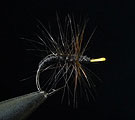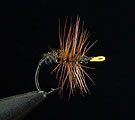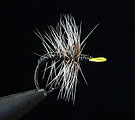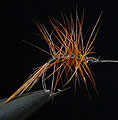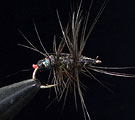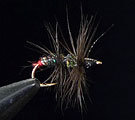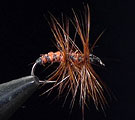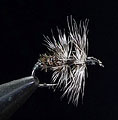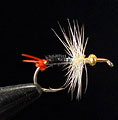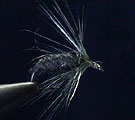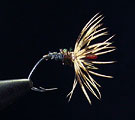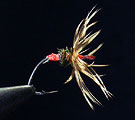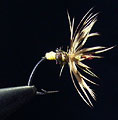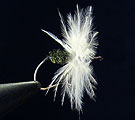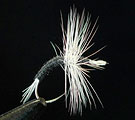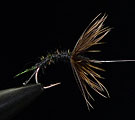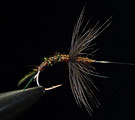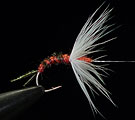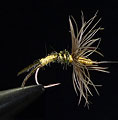Traditional Japanese Fly Tenkara 1 |
 |
| There are flies I got at various places or tied by myself. It is interesting that tenkara fly has local color. |
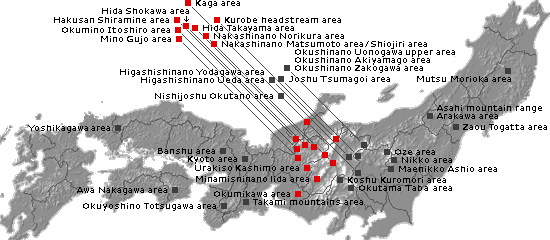 |
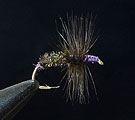 |
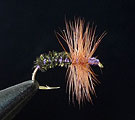 |
 |
 |
|||
Kurobe headstream area
Deep in Kurobe that was not able to go since it was managed by Kaga Han (Domain) at the Edo period.
Its management (Okuyama mawari yaku) was abolished in Meiji Restoration 1870,
so the commercial fisherman Toyama Shinaemon in Taira-mura Shinano (Omachi Nagano) built "Taira no koya (Hut)" and he began iwana fishing and hunting in the next year.
Mr. Yasataro Shitaka of Ashikuraji Toyama managed the hut, and performed the commercial fishing from 1917.
Mr. Kakuei Saeki of Ashikuraji began to manage the hut in 1948.
He tried to learn the secret of iwana fishing from Yasataro, but was able to ask only how to make kebari.
Construction of Kurobe Dam was started in 1956, and "Taira no koya" sank in the dam lake.
New "Taira no koya" was built in the position high 100 m from the original place in 1963, and after Mr. Satohide Saeki, Mr. Satonori Saeki has inherited the hut now.
Traditional kebari of Ashikura Toyama that are used over three generation in Kurobe.
These are kebari of Mr. Satonori Saeki that I replicated.
The hackle is brown color or black color rooster.
The body is tied together by peacock herl and purple silk thread.
It seems that it imitated a fly and a beetle.References: Imanishi, Y. (1992). The nature story of Kurobe. Tokyo: Houken Corp. Isojima, I. (2011). Ashikura guide no keifu [Genealogy of Ashikura guide]. Research bulletin. 11, Toyama: Tateyama Caldera Sabo Museum. Koyama, G. (1991). Kurobe no Yasataro. Tokyo: Ateneshobo. |
||||||
 |
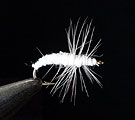 |
 |
 |
||||
Nakashinano Norikura area
The flies of Mr. Makio Okuhara who is a son of commercial fisherman Mr. Yuritaro Okuhara,
and fished the stream of Norikura from around 1965 to around 1986,
and delivered iwana to Nagawa hot spring Fukinoyu.
He opened the fishing-tackle shop at Matsumoto in 1975,
and tied the fly that was taught by his father,
and was named "Sanpei Kebari" from his shop name, and had sold it.
The hook was iseama No.6,
the body was tied by cotton thread of black,
the hackle was black color of bantam,
and about 60cm tippet of No.1 (4X) was attached.
I have heard that a fly with an eye was made for Western style fly-fishing since requested.
Mr. Mitsuo Nomura who was taught how to tie a fly by Mr. Yuritaro Okuhara and many commercial fishermen played an active part at streams in Norikura.
The flies were given me by Mrs. Makio Okuhara.References: Tokado, H. (2013). Shokuryoshiden [Lives of Commercial Fishermen]. Tokyo: Rural Culture Association. |
|||||||
 |
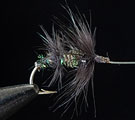 |
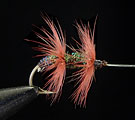 |
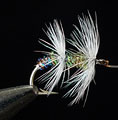 |
||||
Nakashinano Matsumoto area
I found the "Kebari of Double Hackle" which were taken together with the fishing tackle shop stickers and shops card in the photo that was sent from my fishing friend.
Because I was able to understand that the kebari were bought at Matsumoto of Nagano Prefecture by the shop card, I contacted the fishing tackle shop to hear various things.
It was revealed that these kebari are the same as the kebari of Shiojiri and Iida of the following, is a pattern that have been used since long ago also around Matsumoto;
and these have been used in the wide area such as the main stream and branch of the Azusagawa River, the Saigawa River and the Hakuba area in addition to the Kisogawa River and the Naraigawa River.
(Map of rivers where "Kebari of Double Hackle" have been used.)
I heard that Kebari had been tied by the grandfather of fishing tackle shop owner in the 1950s, and the production of Kebari are commissioned to a fly hook workshop of Banshu (Hyogo) now.
The hook is Sodegata No.10 (Western hook size #10) and the tippet of about No. 2 (2X) has attached 30cm.
The body of left fly is tied the copper wire.
It has the brown hackle in addition to the black hackle. |
|||||||
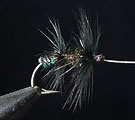 |
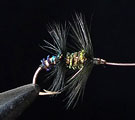 |
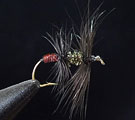 |
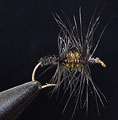 |
||||
Minamishinano Iida area
These flies were sold at the fishing tackle shop in Iida of Nagano before.
These are the same as above-mentioned Shiojiri kebari and this pattern is reminded of Renegade-fly of Western type.
Left two flies are stamped in the package with "Yamame,Iwana-bari Ginrin crystal (Tippet name of Toray)".
The hook is Sodegata No.9 (Western hook size #11) and the tippet is No.1.5 (3X).
Right 2 flies has a label of "Banshu Nakayama Mitsuo Shoten's mark No.10 RAINBOW Yamame Iwana".
Morioka Kebari is well known as fly of double hackle, and there was also a thing of same pattern in kebari that I got in Hida Shokawa area but it is rare in other area.
It seems that both of flies were tied by the request of Iida's fishing tackle shop at Nakayama Mitsuo Shoten in Banshu.
Iida is located in the middle of "Sanshu-kaido (Route 153)" that divided from Shiojiri of Nakasendo and reach Okazaki via Mikawa Asuke.
Its route was "Shio no Michi (Salt Road)" of the historical trade route that connects the inland and the Pacific Ocean.
The distance of Iida and Shiojiri is about 80km and the Kisogawa River and the Naraigawa River upper part are not so much distant from Iida, so I think that these flies will have the same origin as fly of Shiojiri.Additional note: Kabari also has a fly pattern called "Kindama Nidanmaki [Gold ball Double hackle] Yamame kebari" but the relationship with the above-mentioned kebari of Matsumoto, Shiojiri, Iida, Hida Shokawa and Morioka are unknown. |
|||||||
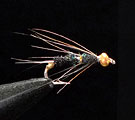 |
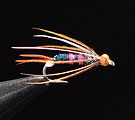 |
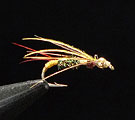 |
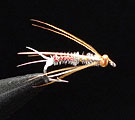 |
|||||
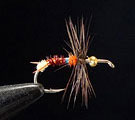 |
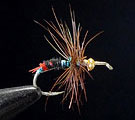 |
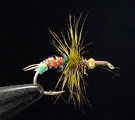 |
|
|||||
Kaga area
Kaga-kebari fly's origin goes back until Edo period.
Kaga is present Ishikawa Prif.
At that time, Kaga Domain encouraged the river fishing (sweetfish) as samurai's privilege,
and competed for not only the fishing results but also the making and the beauty of their flies.
In the Meiji period (1868-1912), anybody was allowed to enjoy fishing, and selling flies became businesses.
Kaga's artificial flies for the sweetfish were displayed at National Exhibition in 1890, and they were praised for their beauty by the people all over the nation.
The technique of the traditional craft-work of urushi and gold foil is used for small flies.
Photo's are the present kebari for Iwana and Yamame that were tied with the traditional craftsmanship by Meboso Hachirobei Co.
The upper row is the flies to use underwater, and the lower row is the flies to float on the water surface.References: Digital Archives of Ishikawa Japan. Retrieved January 19, 2008. Kaga Kebari Meboso Hachirobei Company. Retrieved July 26, 2017. |
||||||||
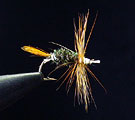 |
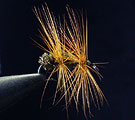 |
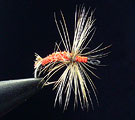 |
 |
||||
Hida Shokawa area
These have brown hackle or ginger hackle, body of peacock herl or red silk thread. |
|||||||
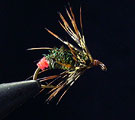 |
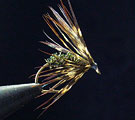 |
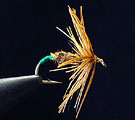 |
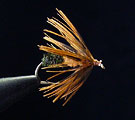 |
|||
Hida Shokawa area
These all have hackle of pheasant's feather, body of cotton of flowering fern and peacock herl. |
||||||
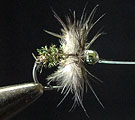 |
 |
 |
 |
||||
Hakusan Shiramine area
Since the Edo period, there is yado (inn) under the rule of Hiraizumi Temple in Ichinose, and it has been used as a mountain climber for Hakusan and a hot-spring cures area.
It came to be called Hakusan Onsen (Hot spring) from the Meiji period to the Taisho period, and many river fishermen have been born to supply Iwana to the ryokan (inn) for staying guests and climbers, and the commercial fishing was done until 1988.
There are almost no persons who can make traditional kebari used in Hakusan Shiramine region (Ushikubigawa water system) now.
"Hakusan Tenkara Kebari" was made by repeating improvement while actually using it by Mr. Toshiya Tsuruno board members of the Fisheries cooperative, etc., in order to inherit it.
It is a kebari with a tippet of about 45 cm 2 go (2X), and is sunk about 10 cm from the water surface and used.
This kebari uses low oil and softer carrion crows' head short feathers (Characterized by white downy barbs.) to improve movement in water, and is used a fishhook (Iseama 6 go) smaller than a general kebari.
In addition, a small bead head of dark olive is attached by the arrangement of a modern style.Additional note: My view on the origins and relevance of the traditional kebari in the Hakusan Mountains "The mystery of Kebari in the Hakusan Mountains". References: Ueuma, Y. (2002). Ichinose Shuhen no Shizen [Nature around Ichinose]. Hakusan no Shizenshi. 22, Ishikawa: Hakusan Nature Conservation Center. Tachibana, R. (2005). Trout and Char Fishing at the Sources of the Tedori 1. Annual report of Hakusan Nature Conservation Center. 32, Ishikawa: Hakusan Nature Conservation Center. Tachibana, R. (2006). Trout and Char Fishing at the Sources of the Tedori 2. Annual report of Hakusan Nature Conservation Center. 33, Ishikawa: Hakusan Nature Conservation Center. Ishikawa Prefecture Hakusan Shiramine Fishery Cooperative Association Press release. Retrieved July 15, 2019. |
|||||||
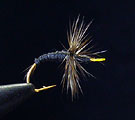 |
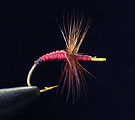 |
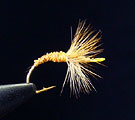 |
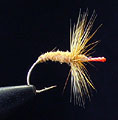 |
||||
Mino Gujo area
These are "Sakasakebari" that has handed down to Mino Gujo area.
These are flies that were remade by modern sense. These have neck hackle, body of silk thread. Eye is made by yellow mono-filament.
The right fly is traditional fly that has body of cotton of flowering fern that I tied. |
|||||||
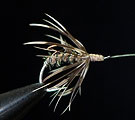 |
 |
 |
 |
||||
Urakiso Kashimo area
Kebari of Urakiso Kashimo-mura(village) of Gifu prefecture side in Adera mountains that is known as a place of production of the hinoki(Japanese cypress) from the ancient times.
(By the municipal merger in 2005, it is Nakatsugawa city Kashimo now.)
The hackle was tied by hen pheasant neck hackle.
The body was tied by cotton of flowering fern.
Wire of shipping tag that was twisted together to peacock eye was used to ribbing of the body.
The style of coiling wire around kebari is the same as kebari of Maenikko Ashio.
This kebari was called "Tenkara" or "Kiji-bari" at Kashimo-mura.
This is Kebari that I reproduced.References: Suzuno, F. (1993). Yamaryou [Mountain fishing]. Tokyo: Rural Culture Association. |
|||||||
Flies |
Equipment |
| Back to Main Home Page | Profile | Links |
Home |
Paper Craft of Japanese Trout and the World Trout © 1997 Yoshikazu Fujioka |
